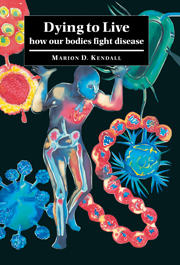7 - Life After Death
Published online by Cambridge University Press: 29 September 2009
Summary
Multiple sclerosis What causes multiple sclerosis is still a mystery, but the strange geographical distribution of its appearance in clusters in certain populations, similar major histocompatibility complex (MHC) genes in many of those affected, more IgG in blood during an attack, autoantibodies to the myelin of the fatty sheath around nerves, and evidence from animals studies of a closely related condition suggest an infectious basis. A common early symptom is inflammation of the nerve to one eye, more often in young women than in children. The disease characteristically flares up in episodes with remissions in between. However, with time, it tends to become relentlessly progressive. The nervous tissue of the brain and spinal column develops hardened regions termed plaques. Here the nerves have lost their fatty protective covering, or sheath, of myelin and there is a strong infiltration of leukocytes into the brain, particularly in the newly formed plaques. This is unusual as brain cells normally restrict the entry of leukocytes by a blood-brain barrier formed from cells within the brain. When this barrier is penetrated, then large numbers of immune cells can enter. Whether these infiltrating cells are making the disease worse or controlling it is unclear. The loss of the myelin sheath results in poor nerve impulse transmission, so that the most devastating practical result of this disease is difficulty in walking.
- Type
- Chapter
- Information
- Dying to LiveHow our Bodies Fight Disease, pp. 109 - 125Publisher: Cambridge University PressPrint publication year: 1998



